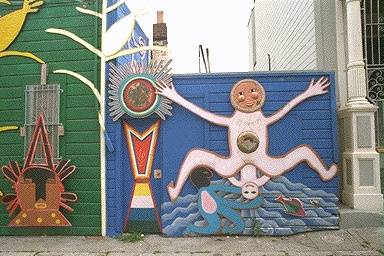Chicano Gay Poets: Difference between revisions
No edit summary |
No edit summary |
||
| Line 24: | Line 24: | ||
[[KENNETH PATCHEN and his Picture-Poems |Prev. Document]] [[Beat Generation and San Francisco's Culture of Dissent |Next Document]] | [[KENNETH PATCHEN and his Picture-Poems |Prev. Document]] [[Beat Generation and San Francisco's Culture of Dissent |Next Document]] | ||
[[category:Literary San Francisco]] [[category:LGBTQI]] [[category:Latino]] [[category:1970s]] [[category:1980s]] | [[category:Literary San Francisco]] [[category:LGBTQI]] [[category:Latino]] [[category:1970s]] [[category:1980s]] [[category:Reclaiming San Francisco]] | ||
Revision as of 21:40, 21 November 2021
Historical Essay
by Juan Felipe Herrera
Balmy Alley murals, between 24th and 25th, part of the explosion of La Raza cultural expression during the 1970s and '80s.
Photo: Chris Carlsson
The first Chicano Gay poets writing collective, "Las Cuarto Espinas," came together in 1985 with their milestone poetry collection, Ya Vas Carnal published by Humanizarte publications, an offshoot of Poetasumanos and El Tecolote Literario, featuring work from the most active writers in the group: Francisco X. Alarcón, Juan Pablo Gutierrez and Rodrigo Reyes. In the mid-eighties, this book, marks the new mission, the "Fifth Form" and perhaps a more radical project than the earlier Tropicalization and Red Nation poetics. Ya Vas Carnal lays down the groundwork for an "out" gay Chicano poetic activism and literary practice.
This is heightened and followed by a hyper-event, larger than the old Mission Cultural Center political factionalism, bigger than anything we have imagined -- the formation of the "Francisco X. Alarcón Defense Fund Committee." From one day to the next, in 1985, Francisco X. Alarcón, one of our poetry carnales is implicated by the police as a suspect in the tragic murder of Teddy Gomez, a young runaway from the East Bay found bludgeoned in Golden Gate Park. Margarita Luna Robles, now living in the Mission, is one of the first to move and organize funds, legal representation and people so that Alarcón gains release from county jail and most of all from the implications of homicide.
Not long after the murderer confessed and Francisco was cleared we come back again; a new awareness filled us: the awareness of bloody body destruction, of Teddy Gomez's story, of the potent Mission literary scene, of writers and artists from various communities and ethnicities joining and speaking out, of Francisco's renewed sense of his gay reality, of our ignorance and separations from what is real in the streets. Awareness, I say, then weaknesses appear the lack of coalitions with gay and lesbian communities in the Mission and the Bay at large, the inner-directed and closed circles of action and community among the poets, artists and writers.
—Juan Felipe Herrera from "Riffs on Mission District Raza Writers" in Reclaiming San Francisco: History, Politics, Culture A City Lights Anthology (City Lights Books: 1998)
In 1992, in an interview with Tede Matthews, one of the few white gay poets that the Latino literary collectives invited to read from time to time, he talks about early activism in the Castro. I am in Tede's apartment, a few blocks from Modern Times Bookstore on Valencia where he coordinates a weekly poetry reading series. His face is gaunt, he holds on to every word, he battles AIDS as best as he can (Tede died in 1995):
"Many years ago, in the early seventies, I was in this gay club on Castro Street ... there used to be Paperback Traffic (bookstore) on the Castro where we started our own poetry reading series.. God.. There were people like Thom Gunn and Robert Gluck reading. We were called the Ho Chi Minh Palace... we were upstairs where the Bakery Cafe was and on the corner was Buffalo Whole Foods. There was a place called the Hula Palace and they were a collective house of gay men.. And every equinox and solstice they would empty their house, repaint it, do a theme art show. We would do an evening of political culture there. They weren't that political, but they would invite the Ho Chi Minh crowd. So, we did an event for the political prisoners of Chile, the whole coup thing,, and we started Gay Solidarity with Chilean Resistance, which was the first solidarity group right after the coup. We did an art show, poster.. at the Hula Palace."

